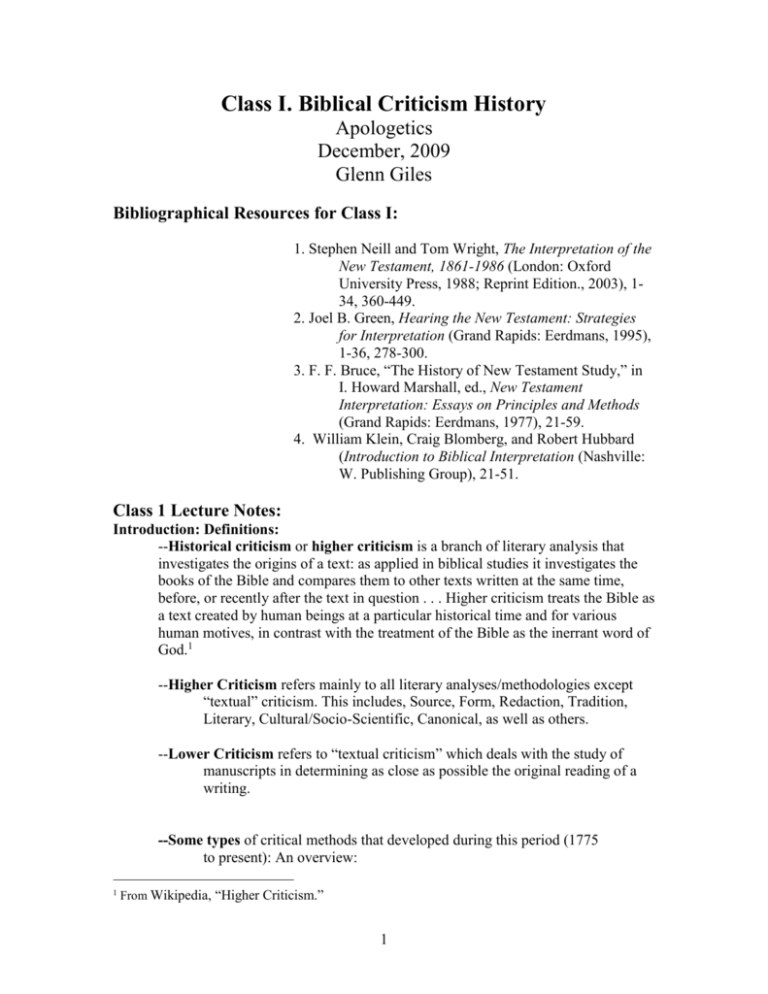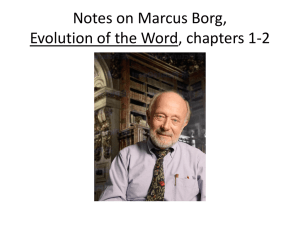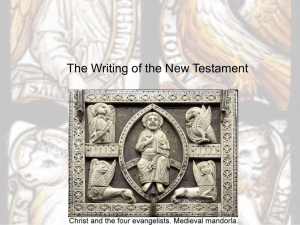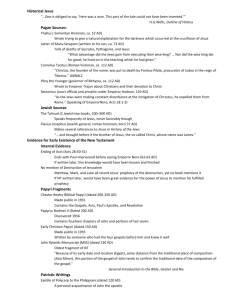Class 1 History of Biblical Criticism
advertisement

Class I. Biblical Criticism History Apologetics December, 2009 Glenn Giles Bibliographical Resources for Class I: 1. Stephen Neill and Tom Wright, The Interpretation of the New Testament, 1861-1986 (London: Oxford University Press, 1988; Reprint Edition., 2003), 134, 360-449. 2. Joel B. Green, Hearing the New Testament: Strategies for Interpretation (Grand Rapids: Eerdmans, 1995), 1-36, 278-300. 3. F. F. Bruce, “The History of New Testament Study,” in I. Howard Marshall, ed., New Testament Interpretation: Essays on Principles and Methods (Grand Rapids: Eerdmans, 1977), 21-59. 4. William Klein, Craig Blomberg, and Robert Hubbard (Introduction to Biblical Interpretation (Nashville: W. Publishing Group), 21-51. Class 1 Lecture Notes: Introduction: Definitions: --Historical criticism or higher criticism is a branch of literary analysis that investigates the origins of a text: as applied in biblical studies it investigates the books of the Bible and compares them to other texts written at the same time, before, or recently after the text in question . . . Higher criticism treats the Bible as a text created by human beings at a particular historical time and for various human motives, in contrast with the treatment of the Bible as the inerrant word of God.1 --Higher Criticism refers mainly to all literary analyses/methodologies except “textual” criticism. This includes, Source, Form, Redaction, Tradition, Literary, Cultural/Socio-Scientific, Canonical, as well as others. --Lower Criticism refers to “textual criticism” which deals with the study of manuscripts in determining as close as possible the original reading of a writing. --Some types of critical methods that developed during this period (1775 to present): An overview: 1 From Wikipedia, “Higher Criticism.” 1 a. Textual Criticism: attempts to get to the original text by comparing and studying all the available copies b. Source Criticism: attempts to find the source(s) behind the extant documents. (E.g., Welhausen and the JEDP theory for the OT Pentateuch, the Synoptic Problem in the NT). c. Form Criticism: Stressed oral tradition and transmission behind the written texts of the Bible. It dissected the Bible into small bits of tradition. It atomized the text. Cf. especially Bultmann and his works. d. Redaction Criticism: Studied the editing of the biblical material by individual authors of the individual books. It looks at each book as a whole attempting to determine the theological purpose intended by the human author in putting together and editing the bits and pieces of tradition. It views Bible books as wholes in contrast to Form Criticism. e. Tradition Criticism: Studies the history of tradition behind the text to see how the tradition in the text developed into what is extant. It has overlaps with Form and Redaction Criticism and the History of Religions School. f. Literary Criticism: stresses the beauty of the Bible texts from an aesthetic point of view looking at rhetorical devices, poetry, narrative development of plot, characters, structural text components, etc. g. Sociological Method: Uses Social-Scientific methods to help interpret the text. Radical elements glean freedom from various types of slavery based on Exodus and other scriptures as the focal point to their theologies, e.g., 1. Feminist Theology 2. Liberation Theology h. Cannon Criticism: Sees the whole canon as the limitation and extent of revealed Scripture for the Church and attempts to interpret Scripture based on its position in the canon. i. Postmodernism: It is skeptical of human objectivity and our ability to know. It does not reject the supernatural but takes a mystical approach to the text. The text is not held to its historical meaning but whatever it means existentially to each individual. Thus there is a pluralistic meaning of each text. There is no one “correct” interpretation. There are many approaches to God and it does not matter as long as you are sincere in your convictions about what you believe. Hence all interpretations are correct, except one that claims that this is not true. 2 I. Biblical Interpretation History: Orthodoxy2 A. New Testament Period through the Reformation (100 to around 1750) 1. Orthodox interpretation is held and is sustained even when challenged by Gnostics, Marcion from the NT times until modern times. 2. Orthodox Christian Worldview: Some principles a. God exists, and is infinite, personal, transcendent, immanent, omniscient, sovereign and good. b. God is Creator of the world and created it out of nothing to operate as an open system of uniform cause and effect. He is able and does work miracles in real history. c. Jesus was real physically in history not a person created later by the church to support its belief that Jesus was both man and God, both human and Divine. His nature, character, earthly life history, and will is revealed in the New Testament. d. Man is made in the image of God and as such reflects that, yet is marred by sin. His reason is limited by his finiteness and thus needs special revelation in addition to general revelation to see the big picture God wishes him to see. e. NT Scripture is God’s special inspired revelation communicated in written human language using human minds and hands under the direction of the Holy Spirit. B. After 1750 the Orthodox interpretation begins to be challenged. II. Challenge to Orthodoxy: The Birth of the Historical Critical Approach: A. Biblical Criticism Historical Overview: Modern to Post-modern (1750Present) 1. Birth of the Historical Critical Approach: Interpretation based on human reason and a naturalistic worldview. In the radical forms, the Bible is not considered God’s special revelation but written by human beings. Everything (especially miracles) had to be explained naturalistically (through the laws of physics, biology, and chemistry, evolution, etc.). The supernatural is locked out of interpretation. The Bible is interpretatively approached as any other human book. 2. Important personages and precursors in the development of modern NT criticism: a. Johann Salomo Semler, Treatise on the Free Investigation of the Canon, four volumes (1771-75). --reaction against “pietistic sanctimoniousness” of the church (Green, 11). --against “manipulative religion,” church or Bible has no special authority. All practical belief in the “The word orthodox, from Greek orthodoxos ‘having the right opinion’, from orthos ("right", "true", "straight") + doxa ("opinion" or "praise", related to dokein, "to think"), is typically used to mean adhering to the accepted or traditional and established faith” (Wikipedia, “Orthodoxy”). 2 3 inspiration of the Bible was set aside (Green, 13). --wanted to “free all historical inquiry from issues of theology and doctrine” (Green, 12). In this way the New Testament would be liberated from “eighteenth-century ecclesial assumptions” (Green, 13). b. Herman Samuel Reimarus and Gotthold Ephraim Lessing. --Lessing publishes Reimarus’ Fragments (1774-78). This book approached the NT from a non-theological historical manner and “explicitly claimed that every hint of supernatural or other-worldly agency in the NT represented an addition imposed by sheer illusion” (Green, 14). It was claimed that the earliest Christians made up fictitious accounts of the miraculous accounts of Jesus’ life. The New Testament Church distorted “the history of Jesus to sustain its own power interests” (Green, 15). --Lessing proposes an Aramaic Gospel which predated the canonical gospels which was used by the Evangelists as a source in the writing of their gospels. c. Johann Jakob Griesbach --“marks the transition from the ‘post-Reformation’ to the ‘modern’ age of New Testament Study” (Bruce, 38). --Textual Criticism: published the first critical edition of the Greek NT (1774-75) and classified the Greek manuscripts into three types: Alexandrian, Western, and Constantinopolitan (1776). --Originated the term “synoptic gospels.” Felt Mark was dependent on Matthew and Luke (Bruce, 38). d. Johann David Michaelis publishes his fourth edition of Introduction to the New Testament (1778) which becomes “the first of the genre of modern studies” (Green, 14) --here he examines each NT book critically with respect to its origins, date, purpose, authorship, and history of its text. e. Wilhelm Martin Leberecht de Wette (1780-1849). --proposed that there were three strands in the NT a. Jewish-Christian (depicted by the Synoptic Gospels, most of Acts, James, Peter, Jude and Revelation) b. Alexandrian (Hebrews and John’s writings) c. Pauline (Paul’s letters) (Bruce, 39). --Hence this developed the idea of several “theologies” in the NT (i.e., different interpretations of Jesus and his message by proponents of these three strands). f. Friedrich Daniel Ernst Schleiermacher (1768-1864) 4 --psychoanalyzed the Gospels in his Lives of Jesus (published after his death in1864) and concluded that “the resurrection of Jesus” was a “resuscitation after apparent death, and the supernatural features in the accounts of his appearances to the disciples” and were due “to presuppositions on the part of the later” (Bruce, 40). g. David Friedrich Strauss (1808-1874), The Life of Jesus Critically Examined (1846). His was the beginning of the “flight from history” (Green, 20). --bifurcates faith and history. The Christ of faith is not the Jesus of history. --Strauss could not believe in a “transcendent God intervening in the life of the world, and . . . found it impossible to accept the gospel witness to Christ” (Bruce, 40) --He replaced the rational understanding of the Gospels with a “mythological interpretation.” Messianic understandings of the Messiah from the OT, contemporary Jewish expectations, and all supernatural conceptions of Jesus were “read back” onto the historical Jesus by the early church and the Gospel writers. Those “myths became absorbed into the narrative account” (Green, 22-23). h. Ferdinand Christian Bauer (1792-1860) --argues that the NT depicts a Petrine (Jewish) vs. Pauline (Gentile) theological community tradition conflict. Hence there was a sharp conflict between Jewish Christianity that embraced legalism and Gentile Christianity that embraced freedom from legalism. This is depicted in Gal. 2 --He embraced the Hegelian dialectic of thesis and antithesis with respect to these two elements of Christian history. From this he dates Acts (where Peter and Paul seem to be united, esp. chapter 15) in the Second Century AD to allow enough time for the synthesis to occur. Hence the early church had falsified Acts by placing it historically in the first century before the synthesis could have taken place (Green, 34). --Bauer also ascribed a second century date to the Gospels and as such their historical value to the life and teaching of Jesus was greatly reduced and questioned (Bruce, 42). --He continued the critical tradition in not allowing any supernatural elements in the NT to be part of real history. i. William Wrede, The Messianic Secret (German, 1901) --claimed that Mark’s emphasis on keeping the 5 knowledge of Jesus as the Messiah or Son of God secret was an attempt “to reconcile the church’s belief that Jesus was Messiah and Son of God from the beginning with the fact that this belief did not emerge until after the resurrection” (Bruce, 46). --hence Wrede claims that the writer of Mark “redacted” the story to explain how the above took place, i.e. via the Messianic Secret. --Wrede becomes the father of Gospel redaction criticism (Bruce, 46). -- To him Jesus was only a “Galilean teacher or prophet who did some striking things and was eventually executed” (N. T. Wright, Jesus and the Victory of God, 20) j. Albert Schweitzer, The Quest for the Historical Jesus (1910). --claimed the life of the historical Jesus could not be written. It has been lost in history. --he proposed a “thorough-going eschatology” in which Jesus was an “apocalyptic visionary, who at the end exposed himself to arrest and execution in order that his death might precipitate the Kingdom of God and the end of history which he had announced but which had proved unexpectedly slow in arriving (Bruce 46). Jesus was a Jewish apocalyptic prophet who proclaimed the kingdom of God but died disappointedly when that eschatological kingdom did not come. k. Rudolf Bultmann (Die Geschichte der synoptischen Tradition (1921), English Translation: The History of the Synoptic Tradition (1963) and Martin Dibelius (Die Formgeschichte des Evangeliums (1919). --Pioneers in NT Form Criticism (i.e. oral tradition behind the written NT documents) following Herman Gunkel, E. Sievers, and S. Mowinckel’s application of Form Critical principles to the OT. --Bultmann promoted demythologizing the New Testament --Bultmann and the “new hermeneutic” (Bruce, 51-52) wanted to approach the NT not so much historically as with a concern for “human existence,” one’s “authentic existence” based on “existential exegesis” (Bruce, 52). The emphasis is on “Jesus as ‘the proclaimed’ rather than the historical ‘proclaimer’” (Green. 24). l. B. H. Streeter, The Four Gospels (1924) proposed the foursource hypothesis of the origin of the Synoptic Gospels: Mark, Q (material common to Luke and Matthew), M (material unique to Matthew), and L (material unique to Luke). 6 m. Ernst Kasemann (1953), Bultmann’s student, proposed a “new quest” for the historical Jesus. He felt that Bultmann had gone too far in claiming that history and the historical Jesus had nothing to do with faith. He was followed by J. M. Robinson, A New Quest of the Historical Jesus (1959) --Both reacted against the extreme negative view of history in the Gospels advanced by Bultmann. 3. Summary: --By 1860 “criticism had come to stay, and . . . henceforward the Bible would be treated like any other book” (Neill and Wright, 3334), i.e., uninspired, non-God breathed. --By the end of the 19th century, the historical Jesus could not be found by Biblical critical scholars. --By 1950 or earlier faith was divorced from history, became existential, and miracles were myths. By this time Orthodoxy was challenged to such a great extent that Jesus’ resurrection and other miracles were seen as non-historical creations of the early Christians/church. Naturalistic interpretation reigned and God was locked out of reality and history. The physical Jesus of history is lost and the Christ of existential faith is created. From this basis of detachment from history, the demythologizing of the NT, and attachment to existential interpretation, a plethora of different types of interpretative methods developed. --By the 1990s pluralistic Post-modern interpretation of the Bible is embraced. All truth is relative. B. Orthodoxy Defended: Grammatico-Historical Method --Opposes radical anti-historical modern Biblical criticism: 1. Holds to inspiration of the NT, focus on word and grammatical study, context study, historical/cultural/background studies, biblical theology input, systematic theology input, archaeological input. Assumes the historicity of the text. 2. Brooke Foss Westcott (1825-1901), John Anthony Hort (18281892) and Joseph Barber Lightfoot (1828-1889) and the Cambridge School --re-established the NT to be dated in the first century AD and thus supported its historical reliability. 3. Sir William Ramsay (1851-1939), archeology -- helped establish the historicity of Acts and the Pauline epistles. 4. Conservative Evangelicals: Inerrancy and historicity defended. -- Princeton School in the 1920’s with B. B. Warfield and J. Gresham Machen --Many other modern day evangelical scholars and schools 7 including Trinity Evangelical Divinity School, Fuller Theological Seminary, Gordon-Conwell Theological Seminary, etc. 5. Restoration Movement: Goal of Restoring NT Christianity principles. Alexander and Thomas Campbell, Barton Stone, J. W. McGarvey and many others. a. Tom Olbricht, "Hermeneutics," in The Encyclopedia of the Stone-Campbell Movement, Douglas A. Foster, Paul M. Blowers, Anthony L. Dunnavant, and D. Newell Williams, eds. (Grand Rapids: Eerdmans, 2004). b. Eugene Boring, Disciples and the Bible: A History of Disciples Biblical Interpretation in North America (Atlanta: Chalice Press, 1997) III. Class discussion on the ramifications of believing in a Christ of Faith who is not the Jesus of History. Selected Bibliography for Biblical Criticism Study Glenn Giles 2009 Barclay, William. Introduction to the First Three Gospels. Revised Edition. (Philadelphia: The Westminster Press, 1975). Blomberg, Craig. The Historical Reliability of the Gospels (Downer’s Grove: IVP Academic, 1987). Briggs, R. C. Interpreting the New Testament Today: An Introduction to Methods and Issues in the Study of the New Testament. (Nashville: Abingdon Press, 1973). Bultmann, Rudolph. The History of the Synoptic Tradition. (New York: Harper & Roe, 1963). Carson, D. A.; and Moo, Douglas J. An Introduction to the New Testament. (Grand Rapids: Zondervan, 2005). Elliott, J. H. What is Social-Scientific Criticism? (Minneapolis: Fortress, 1993). Eugene Boring, Disciples and the Bible: A History of Disciples Biblical Interpretation in North America (Atlanta: Chalice Press, 1997). 8 Foster, Douglas A.; Blowers, Paul M.; Dunnavant, Anthony L.; and Willliams, D. Newell, Editors. The Encyclopedia of the Stone-Campbell Movement. (Grand Rapids: Eerdmans, 2004). Funk, Robert W.; Hoover, Roy W.; and The Jesus Seminar. The Five Gospels: The Search for the Authentic Words of Jesus. (New York: Macmillan, 1993). Gerhardsson, Birger. The Reliability of the Gospel Tradition. (Peabody, MA: Hendrickson Publishers, 2001). Giles, Glenn The Jesus Seminar and Radical Higher Criticism (unpublished article, 2007). Green, Joel B. Hearing the New Testament: Strategies for Interpretation (Grand Rapids: Eerdmans, 1995). Green, Joel B.; McKnight, Scot; and Marshall, I. Howard, Editors. Dictionary of Jesus and the Gospels. (Downers Grove: IVP, 1992). Greenee, J. Harold. An Introduction to New Testament Textual Criticism, Revised Edition (Peabody, MA: Hendrickson, 1995). Guthrie, Donald. New Testament Introduction. (Downer’s Grove: IVP, 1990). Jeremias, Joachim. The Parables of Jesus. Second Revised Edition. (New York: SCM Press, 1972). Johnson, Luke Timothy. The Real Jesus: The Misguided Quest for the Historical Jesus and the Truth of the Traditional Gospels. (San Francisco: Harper, 1997). Klein, William; Blomberg, Craig; and Hubbard, Robert. Introduction to Biblical Interpretation. (Nashville: W. Publishing Group, 1993). Marshall, I. Howard, Ed. New Testament Interpretation: Essays on Principles and Methods. (Grand Rapids: Eerdmans, 1977). McDowell, Josh. Evidence that Demands a Verdict, Vol. 1 (Arrowhead Springs, CA: Campus Crusade for Christ, 1977), McKnight, Scot. Introducing New Testament Interpretation. (Grand Rapids: Baker, 1989). McKnight, Scot; and Osborn, Grant R. The Face of New Testament Studies: A Survey of Recent Research (Grand Rapids: Baker Academic, 2004). 9 Metzger, Bruce M.; and Ehrman, Bart D. The Text of the New Testament: Its Transmission, Corruption, and Restoration, 4th Edition. (Oxford: Oxford University Press, 2005). Neill, Stephen; and Wright, Tom. The Interpretation of the New Testament, 1861-1986 (Oxford: Oxford University Press, 1988, Reprint Edition., 2003). Rhodes, David; and Michie, Donald. Mark as Story: An Introduction to the Narrative of a Gospel. (Philadelphia: Fortress, 1982). Ryken, Leland. How to Read the Bible as Literature . . . and get more out of it. (Grand Rapids: Zondervan, 1984). Stein, Robert. Gospels and Tradition: Studies on Redaction Criticism of the Synoptic Gospels. (Grand Rapids: Baker, 1991). Strimple, Robert B. The Modern Search for the Real Jesus: An Introductory Survey of the Historical Roots of Gospels Criticism. (Phillipsburg: P & R. Publishing, 1995), Tidball, Derek. The Social Context of the New Testament: A Sociological Analysis (Grand Rapids: Zondervan, 1984). Wilkins, Michael J.; and Moreland, J. P., Editors. Jesus Under Fire. (Grand Rapids: Zondervan, 1995). Wright, N. T. Jesus and the Victory of God. (Minneapolis: Fortress, 1996). 10








